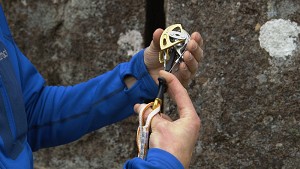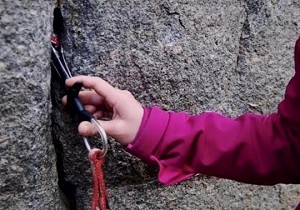

© co1ps, Nov 2006
New or inexperienced cam users may however find this advice confusing and/or overly technical. Therefore, I have done my best to provide a breakdown of the advice in layman's terms based on my personal experience.
CLEANING AND LUBRICATION OF CAMMING DEVICES
- What lubricant should be used? The common examples usually quoted are things like WD40 or cycle chain lubricant such as GT85. Opinion is divided, and in some cases quite polarised, about as to which is best. Some argue that lubricants, such as WD40, that are "sticky" actually attract and retain dirt within the lubricant. They may well be correct but personally, I have never found this to be a significant problem and if your cams are regularly cleaned and lubricated, it should not be an issue. Occasionally dark, maybe black, gunk may come out of the mechanism. This is nothing to get over excited about providing the mechanism continues to move freely.
- Does it matter if lubricant gets on the tape/sling? The concern is that the lubricant will degrade the tape/sling. If you are concerned and there is some overspray, then wash the tape/sling as per method given previously. However, with a bit of care the problem can be avoided initially by holding the cam with the tape in the closed palm of your hand and directing the spray into the moving parts. The paranoid (or those who have two left hands) can secure a small plastic bag over the tape with a rubber band before they start spraying.
- My cams have been in my bag and the mechanism won't work! Usually not the disaster it might seem to be. Try the basic 'wash and lubricate' and gradually try to operate the mechanism to induce movement. If this fails then carefully try to move the cams with your hands. At no point must you force either the mechanism or the cams. If this fails try soaking in warm water then lubricate again and repeat. Still no joy? Thoroughly soak the mechanism in lubricant and leave for a few hours/overnight. If it is still stuck you could be stuffed but this would be a most uncommon experience.
- How often do I need to do this? The last problem can of course be avoided by regular cleaning and maintenance from the outset. Which begs the question - how regular is regular? Depends on how often you climb, where you climb and how you store the cams is the answer! Personally, two or three times a year seems appropriate - hardly a big chore given that a full set of cams can be cleaned and lubricated in the time it takes to have a brew or a beer.
STORAGE
Having got everything clean and working freely, some people then worry about where to keep them until the next trip. The key points about storage are:
- The cams should be stored in a dry and well-aired situation.
- Do not keep them in a plastic carrier bag; this will serve only to induce damp conditions due to condensation and you will risk corrosion. This is particularly so if they have been to the seaside! (see below).
- Do not keep them in a car boot as you risk exposure to god-knows-how-many chemicals, bashing, and of course - they can be stolen.
- If you really are concerned clean, lubricate and dry then place loosely in a cotton bag (e.g. old pillowcase) and store in the back of the airing cupboard.
CAMMING DEVICES AND SEACLIFF CLIMBING
Going to the seaside with your cams seems to result in surprise from some climbers when corrosion occurs or cams otherwise appear to misbehave due to contamination with salt water. So here are some notes to avoid the worst.
- Make sure everything is in working order before you even set off by cleaning, drying and lubricating as described above. This also gives you the chance to inspect everything to make sure: moving parts move, wires are not frayed or broken, the stuff still looks something like it did when you bought it in the shop.
- For those with a corrosion paranoia, give the whole lot a good spraying with chosen lubricant (KY jelly not recommended as its water soluble) but take care to avoid getting any on the tape/sling. For the rest of us, just lube up any moving parts.
- Dry overnight in the airing cupboard. In order not to get it mixed up with the kid's socks and wife/husbands underwear, stuff the whole lot in a couple of pillow cases and hang up. Before you head off remember to collect the kit and put it in your rucksack.
- At the chosen climbing location (and when not in use) keep the kit in a dry fabric bag e.g. a pillowcase. Do not put it in a supermarket carrier bag (or similar) especially when wet. All this will do is create warm/humid/wet conditions - ideal for corrosion. At least in a pillow case the stuff will breathe and probably dry out.
- If the kit gets wet with seawater or picks up a load of sand/dirt/grit then you can wash it at the campsite, caravan or hotel. Take it in the showers/dish washing sink/river and clean. Dry by laying on grass in sun and repeat lube. Put dry kit back in fabric bag. Before journey home try to make sure kit is at least dry and stored in a suitable way.
- Ideally, cleaning and lubing should be done on the same day you get home, but accepting that most of us can't be bothered and would rather go for a beer/kip/pizza, then the next day if fine. Empty contents of pillowcase in your sink and put the pillowcase in the wash or give it to the laundry person who also cooks your dinner. Wash your kit in clean soapy water – taking care to work moving parts to get rid of grit/sand/bits of your mates' finger etc - and rinse well in clean cold water. Dry overnight in airing cupboard.
- Remove your clean kit from the airing cupboard and inspect, make sure moving things do still move freely. Retire to garage with mug of tea/bottle of beer etc and lubricate all moving parts, as previously described. You may at this point realise things are not moving as freely as they should, especially if they have not been cleaned during the trip so follow recommendations above regarding freeing thing up. You are now done.
Notes:
1. The advice above will reduce the risk of things corroding but it will not entirely prevent it, so don't surprised to find a few spots of corrosion here and there or some discolouration of aluminium or even alleged 'stainless steels'.
2. Actual maintenance of the moving parts cannot be undertaken by the user but should be sent back to the manufacturer. Some manufacturers may refuse to repair cams they consider too old. In addition, some manufacturers do make cam repair kits. See Black Diamond repair kits for Camalots

















Comments